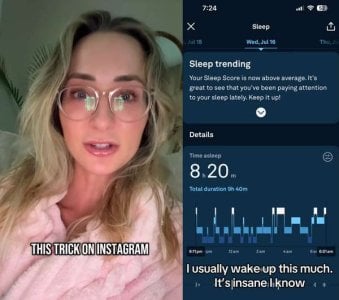Are 3am wake-ups ruining your sleep? Try this simple trick for instant results!
- Replies 2
We’ve all been there: you’re tucked up in bed, dreaming away, when suddenly—bam!—your eyes snap open at 3am.
You glance at the clock, sigh, and realise you’re wide awake. The house is quiet, the world is asleep, but your mind is racing and sleep feels a million miles away.
Sound familiar? If so, you’re not alone—and there might just be a surprisingly simple trick to help you drift back off in no time.
A popular sleep trick making waves online promises to help you fall back asleep 'instantly'—and it’s so easy, you can do it without even getting out of bed.
Jenna Coak, a nurse and sleep enthusiast, shared this nifty tip with her followers after discovering it on Instagram. She calls it the 'best' sleep trick she’s ever tried, and she’s got the data to back it up!
Here’s how it goes: with your eyes closed, look to the right, then to the left, then up, then down. Next, roll your eyes in a circle one way, then the other. Repeat this sequence until you feel yourself drifting off.
Sounds a bit like a bedtime hokey pokey, doesn’t it? But Jenna swears by it. She even shared her sleep stats from her Oura ring—a smart device that tracks sleep quality—to show the difference.

Before trying the trick, she was awake for about an hour and a half during the night, often tossing and turning between 3am and 5am.
After using the trick, her awake time dropped dramatically to just 24 minutes, with far fewer and shorter wakeful periods.
'It feels like some voodoo magic,' Jenna laughed, noting that on one night, she only had to do the process twice before falling back asleep.
It might sound a bit out there, but there’s actually some science to support this technique. Australian sleep expert Olivia Arezzolo explains that this pattern of eye movement is called 'bilateral stimulation.'
It increases connectivity between the right and left hemispheres of the brain, which can help reduce anxiety—a common culprit behind those pesky 3am wake-ups.
Plus, the trick requires just enough mental focus to distract you from the endless loop of thoughts that often keep us awake. It’s a form of cognitive reframing, pulling your attention away from worries and onto something simple and repetitive.
Best of all, it keeps you away from your phone—a notorious sleep saboteur that can make things worse by increasing anxiety and restlessness.
Waking up in the middle of the night is more common than you might think, especially as we get older.
Our sleep cycles change, and factors like stress, anxiety, alcohol, and caffeine can all play a role. According to Arezzolo, high cortisol levels (the stress hormone) are often to blame.
While this eye movement trick can help you get back to sleep, the real key to reducing those wake-ups is managing your stress levels. That might mean winding down with a good book, practising meditation or breathwork, or even cooling your core body temperature before bed.
Source: @jenna_coak / Tiktok.
Sleep aids like magnesium and ashwagandha can also help, as can avoiding blue light from screens in the hour before bedtime.
If the eye movement trick isn’t quite your cup of tea, don’t worry—there are plenty of other strategies to try:
Read more: Shocking Sleep Trend Sweeping Australia - Is It Affecting Your Health? Experts Reveal Startling Findings!

Have you tried the eye movement trick, or do you have your own secret for getting back to sleep after a 3am wake-up? We’d love to hear your tips, tricks, and stories! Share your experiences in the comments below!
You glance at the clock, sigh, and realise you’re wide awake. The house is quiet, the world is asleep, but your mind is racing and sleep feels a million miles away.
Sound familiar? If so, you’re not alone—and there might just be a surprisingly simple trick to help you drift back off in no time.
A popular sleep trick making waves online promises to help you fall back asleep 'instantly'—and it’s so easy, you can do it without even getting out of bed.
Jenna Coak, a nurse and sleep enthusiast, shared this nifty tip with her followers after discovering it on Instagram. She calls it the 'best' sleep trick she’s ever tried, and she’s got the data to back it up!
Here’s how it goes: with your eyes closed, look to the right, then to the left, then up, then down. Next, roll your eyes in a circle one way, then the other. Repeat this sequence until you feel yourself drifting off.
Sounds a bit like a bedtime hokey pokey, doesn’t it? But Jenna swears by it. She even shared her sleep stats from her Oura ring—a smart device that tracks sleep quality—to show the difference.

An Aussie nurse shared a viral 'eye movement' trick on social media, claiming it helps you fall back asleep quickly if you wake up in the middle of the night. Image source: @jenna_coak / Tiktok.
Before trying the trick, she was awake for about an hour and a half during the night, often tossing and turning between 3am and 5am.
After using the trick, her awake time dropped dramatically to just 24 minutes, with far fewer and shorter wakeful periods.
'It feels like some voodoo magic,' Jenna laughed, noting that on one night, she only had to do the process twice before falling back asleep.
It might sound a bit out there, but there’s actually some science to support this technique. Australian sleep expert Olivia Arezzolo explains that this pattern of eye movement is called 'bilateral stimulation.'
It increases connectivity between the right and left hemispheres of the brain, which can help reduce anxiety—a common culprit behind those pesky 3am wake-ups.
Plus, the trick requires just enough mental focus to distract you from the endless loop of thoughts that often keep us awake. It’s a form of cognitive reframing, pulling your attention away from worries and onto something simple and repetitive.
Best of all, it keeps you away from your phone—a notorious sleep saboteur that can make things worse by increasing anxiety and restlessness.
Waking up in the middle of the night is more common than you might think, especially as we get older.
Our sleep cycles change, and factors like stress, anxiety, alcohol, and caffeine can all play a role. According to Arezzolo, high cortisol levels (the stress hormone) are often to blame.
While this eye movement trick can help you get back to sleep, the real key to reducing those wake-ups is managing your stress levels. That might mean winding down with a good book, practising meditation or breathwork, or even cooling your core body temperature before bed.
Source: @jenna_coak / Tiktok.
Sleep aids like magnesium and ashwagandha can also help, as can avoiding blue light from screens in the hour before bedtime.
If the eye movement trick isn’t quite your cup of tea, don’t worry—there are plenty of other strategies to try:
- Stimulus Control: If you can’t fall back asleep after 20 minutes, get up and do something relaxing in another room (preferably something tech-free, like reading). Only return to bed when you’re feeling sleepy again.
- Lavender: The scent of lavender can activate your parasympathetic nervous system, helping you relax and prepare for sleep.
- Red-Tinted Lighting: If you need to get up, use red night lights or lamps. Regular lighting can increase cortisol and make it harder to fall back asleep.
- Mindful Breathing or Meditation: Gentle breathwork or a short meditation can calm your mind and body, making it easier to drift off.
Read more: Shocking Sleep Trend Sweeping Australia - Is It Affecting Your Health? Experts Reveal Startling Findings!
Key Takeaways
- An Aussie nurse shared a viral 'eye movement' trick on social media, claiming it helps you fall back asleep quickly if you wake up in the middle of the night.
- The trick involves closing your eyes, looking right, left, up, down, and rotating them in circles both ways – repeat until you nod off again.
- Sleep expert Olivia Arezzolo says the trick works by distracting your mind and helping reduce anxiety, and it’s better than using your phone, which can make sleeplessness worse.
- While the eye trick can be effective, managing stress, keeping your core temperature cool, using magnesium or ashwagandha, and reading under red light are also recommended for improving sleep.
Have you tried the eye movement trick, or do you have your own secret for getting back to sleep after a 3am wake-up? We’d love to hear your tips, tricks, and stories! Share your experiences in the comments below!







